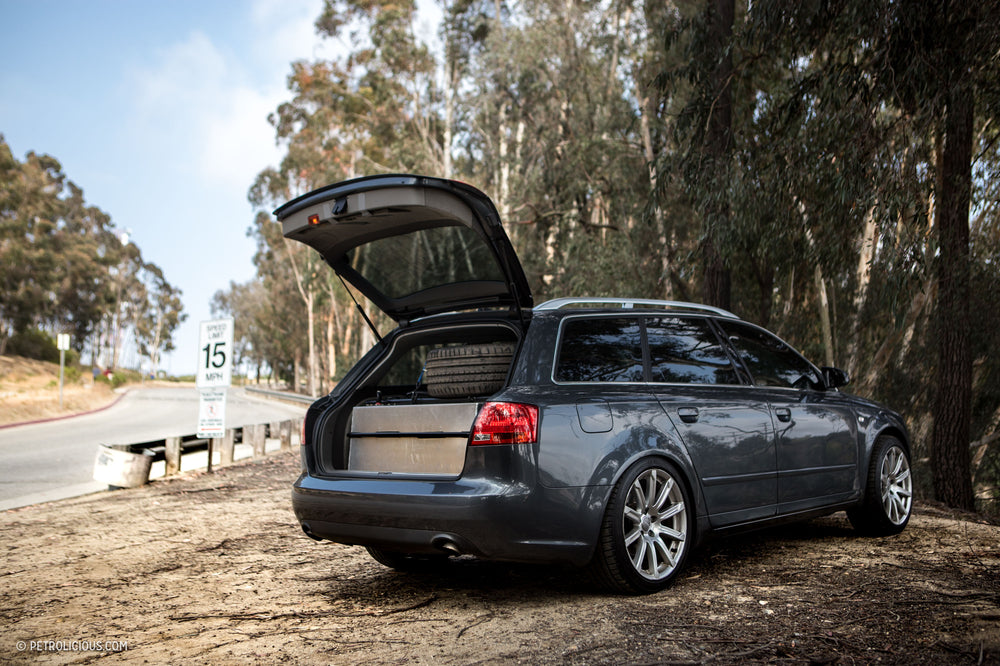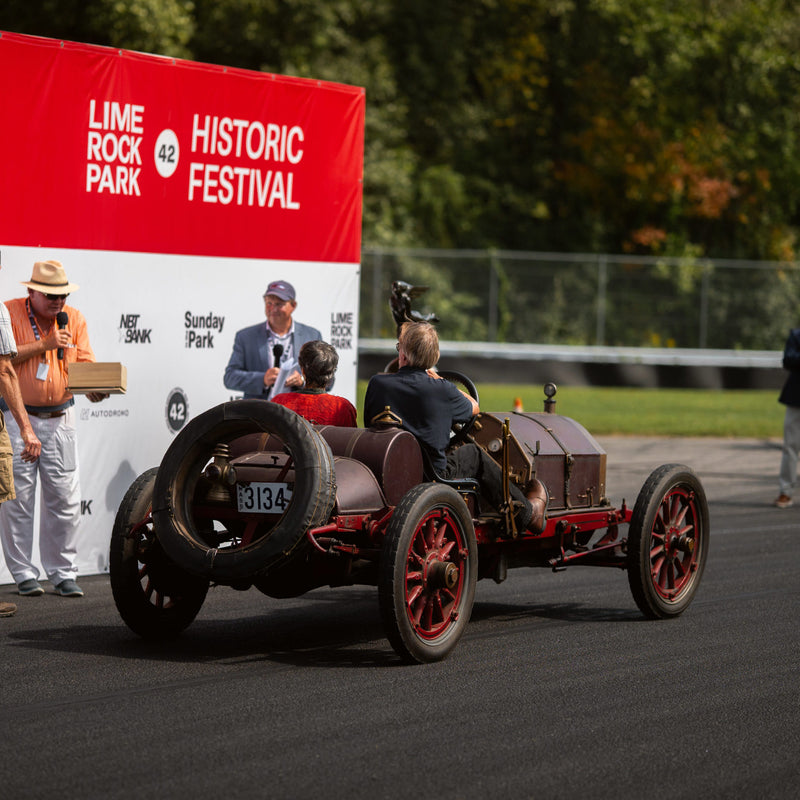Culver City, CA is mostly known for Sony and NPR. I’ve also heard that its school system is one of the best in the LA area, so the sight of a silver late-model Audi Avant could be considered a pretty typical one around these parts. I guess I was blending in then, sitting shotgun as Romuald Clariond drove to find parking near one of the many trendy salad shops in the small but bustling downtown strip. Normally I’d go for something closer to the In’N’Out side of lunch, and normally the Audis here are driven by “young professionals” yapping on their headsets or carrying kids to one of the various activities their parents have signed them up for. Normally the license plates aren’t bearing the coat of arms of Monaco.


Crowded as the place was with the A4’s target market on a Saturday afternoon last fall, I doubt anyone else was packing an auxiliary fuel tank in the trunk good for 100 gallons and change. This is obviously no ordinary car, and if you think the title of this story is misleading, hear me out.
You’ve heard of the Cannonball Run, right? The outlaw cross-country time trial that Brock Yates organized to protest highway speed limits occurred only a handful of times between 1971 and 1979 before he sold the rights to Hollywood on the eve of the ‘80s, and if you haven’t heard of it, I imagine there’s not much explanation needed after reading the phrases “cross-country” and “time trial.”
The history seems to date back to the early ‘30s when a one Edwin "Cannonball" Baker completed the trek in about 53 and a half hours without the advantages of modern interstate systems. Since then quite a few people have attempted the feat in wildly different cars with slightly different strategies, but in summary it’s simply about setting the fastest time on the ultimate American road trip: New York City to Los Angeles. Coast to coast, not on a closed course of course, and one of the few pieces of timed driving where the fastest cars aren’t likely to be the fastest cars. Lamborghinis tend to have higher top speeds than station wagons, but fuel stops use up precious time and approaching top speed will earn an audience of law enforcement more often than not.

Having just completed an attempt at the record with his co-driver Seth Rose last October, Romuald was already close to the Petrolicious headquarters so he asked if I was interested in meeting up to check out the car before he and it went back to Monaco. The Portofino hotel in Redondo Beach is the Point B of the massive sprint that begins at the Red Ball Garage in Manhattan—which was the Point A used in the original Cannoballs—and in the relative sense of the United States’ scale, the 45-minute drive to Culver wasn’t all that much to tack onto the end of his marathon.
I was curious to see what he’d used to cross the country so quickly, and it’s actually not as wild as you might expect. The well-known tools in this discipline are Alex Roy’s E39 M5 and the CL55 AMG that Ed Bolian and co used to beat Roy’s 2006 record when they set a time of 28 hours and 50 minutes in 2013, so in a sense Romuald’s Audi continues the recent tradition of understated German highway killers, but unlike the M and the AMG this is just a humble diesel and far from anything with an RS badge on the back.


The only exterior evidence on this A4—besides the Monaco plates—that something isn’t quite right is a pair of little black boxes front and rear that scramble the lasers used to tell policemen to pull you over. But even then, the speeds weren’t really excessive. It’s all about being consistent, it’s all about planning; the lowest number of pit stops, the least-congested routes, the right time of day to hit the right parts of the country. A heavy foot alone won’t get the job done. Preparation is everything.
And the planning for his 2017 run began years beforehand, when, having caught wind of Bolian’s record when it was announced near the end of 2013, Romuald decided he’d have a go of it too. Living in Monaco meant access to European-market cars, and the choice for him was obvious: “Had to be an Audi.” He’d grown up watching the Quattro domination of nearly every brand of motorsport it entered in the ‘80s and as such the marque had made an early impact on the young enthusiast. In more recent times their TDI technology had proven itself at Le Mans, “dieselgate” notwithstanding, so combined with his love for the stylish profile of their Avants the decision was pretty much made to go with a TDI long-roof.



He started looking in the US initially, but after a year of little luck finding the right 3.0 V6 TDI he turned to cars in Europe which saw him discover the ABT version of the TDI. With the car picked out and the proper example purchased, it was time to outfit it with the right piece of kit to minimize the stops along the way: the standard fuel tank wasn’t going to be enough. And the on-the-market auxiliary tanks wouldn’t either. Given the roomy rump of the car he thought the best course of action would be taking advantage of every cubic inch offered back there, and so he contacted his friend at Rally Fighter USA to build a race-grade unit specifically for this application. He calculated that the additional 103 gallons of fuel carried in the extra trunk-mounted tank would allow him to make the crossing with just a single fuel stop. Alex Roy made six, Bolian three, so despite being down on power and acceleration potential the Audi would take on the role of tortoise to call upon the old allegory.
Alex Roy witnessed their departure from the Red Ball Garage, and at some point during the first half of their journey he called Seth and Romuald to inform them that their pace was almost half an hour ahead of Bolian’s record. You know the end of the story already though.




With their GPS tracker plugged into the car’s OBD port to send the position to the satellites, and with Roy in Manhattan tracking them and staying in close contact, things were looking good for a while and spirits were tentatively high and rising, but problems began stacking up. First there was the issue of traffic leaving the island initially (but that’s almost unavoidable at any hour of the day), then later on Friday night they were blocked again by two semi trucks, this time what seemed to be intentionally. They got around the moving wall eventually though without much time lost, but that wasn't the first unnecessary slowdown; before the truck blocking, they experienced an issue with the transfer pump used for filling the main tank from the auxiliary unit. The dashboard was indicating nothing in the way of range remaining, so Romuald thought there might be an issue with the pump or else one with the gauge itself. They stopped for fuel much earlier than intended in order to diagnose the problem, which turned out to be a gauge issue—more time wasted.
In Oklahoma they stopped at one toll plaza but skipped the next, and were back to making good time again before they passed an F-150 that turned out to be an unmarked cop. He caught up with them and honked and blinked them over to the side of the freeway. The man who exited the pickup looked “like the Rock,” and asked the typical question: “Do you know why I pulled you over?”



Romuald said he had no idea, and with some quick thinking on Seth’s part they managed to avoid a ticket and an even longer delay. “He doesn’t speak English, and the gauges are all in kilometers, he didn’t know he was speeding, you know, they’re used to the Autobahns over there in Europe.”
Romuald played into the part, the officer told them to switch seats, and after telling the pair that he liked the car he let them off on their way again with a different driver behind the wheel this time. The going was a bit slower after that, as it always is after a brush with the law and the looming weight of a repeat occurrence, and then they were thwarted once again by trucks when they had to refuel in Texas. Caught in a line of truckers (they opted for the truck filling stations to top-up the tanks with diesel faster than the standard pumps), the unlucky timing saw them spending 15 minutes waiting for their refresh. It should have been less than five.



When the pair finally pulled the Audi into the Portofino parking lot early on Sunday morning, the time said 30:53, making them the second fastest in history to complete the New York to Los Angeles route. You’d think Romuald would be happy to have achieved such a time, but he says he was filled with disappointment next to the relief of completion. Time was left on the table, and while unforeseen circumstance always rears its head, he knows he can do better. And he’s planning on it.























































